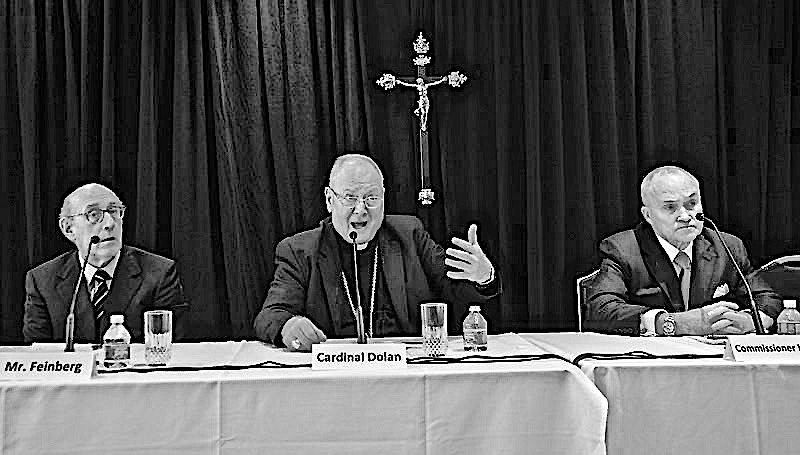The eight Catholic dioceses of New York are bracing themselves against a flood of lawsuits over clerical sexual abuse. A new law, known as the Child Victims Act, was passed early this year and signed by Governor Andrew Cuomo in February. Among the provisions of the new law is a one-year “look-back window,” during which civil cases that had passed the statute of limitations can be revived.
That window opened yesterday, August 14.
New civil suits are being filed. Hundreds, perhaps thousands, more are expected to be filed in the coming weeks and months. (I just Googled “Child Victims Act” and the first four results are advertisements for trial lawyers with offices in New York.)
Given the increased liability for the Catholic Church – and the fact that the bishops of New York trust Governor Cuomo about as far as they can throw him – you might suspect that the bishops would be opposed to the new law. And they were. Or rather, they were opposed to earlier versions of the law, and had been for years. But they withdrew their opposition in late January, just before the bill was passed.
As the bishops said in a statement at the time, “The legislation now recognizes that child sexual abuse is an evil not just limited to one institution, but a tragic societal ill that must be addressed in every place where it exists.”
So what changed? The Catholic bishops wanted several changes in the bill. They hoped to see the statute of limitations dropped entirely for criminal sex-abuse cases; the law merely extends them (along with statutes of limitations in civil cases). The bishops were also reluctant to support the look-back window, for obvious reasons. But they either had a change of heart on that point – or saw the writing on the wall. The real sticking point was a loophole that would have left public institutions – in particular, public schools – largely immune to the kind of exposure non-public institutions (like the Catholic Church) would face under the new law.
New York law requires that a “notice of claim” be filed by a victim before proceeding in a civil claim against a public institution. If that “notice of claim” isn’t filed within 90 days, the suit can’t proceed. The result was that victims of child sexual abuse had just 90 days to decide to take civil action against state and municipal institutions, including public schools.
For years, bishops around the country have insisted that legislation that lifts, or retroactively extends, statutes of limitations for civil suits in child sex-abuse cases ought not single-out the Catholic Church. The Child Victims Act removes the “notice of claim” loophole for cases involving the sexual abuse of minors, both new cases and those that might be brought during the look-back window. When that language was changed in the proposed bill, the Catholic bishops dropped their objections.

The Catholic Church is the primary target for civil litigation over sexual abuse and probably will remain so for the foreseeable future. The demands of justice for victims, the size of the institution, and the financial interests of litigation specialists will see to that. Might it be the case, however, that, as more Catholic cases are settled, the focus will shift to other institutions with shoddy records on child sex abuse? Perhaps. The Boy Scouts, Lutheran Church Missouri Synod, and public-school districts have already had new suits filed against them in the first 24 hours of the look-back window.
As new claims against the dioceses of New York pile up, there is another problem looming. Dioceses, like all big institutions, carry liability insurance. When a diocese is hit with a civil suit, the liability insurance helps cover the costs. But what if insurers refuse to pay claims on the liability policies of Catholic dioceses?
The Archdiocese of New York has already filed a lawsuit against more than 30 insurance firms as a preemptive measure after at least one of the firms indicated it would not pay out for legal fees incurred in cases arising under the new law. The Archdiocese needs to know now – rather than later – if its liability insurance is going to be there when it needs that help most.
Back in 2016, the Archdiocese of New York put in place an Independent Reconciliation and Compensation Program. The program establishes a standing, independent mediator to handle claims against the archdiocese. The idea is to provide compensation for victim-survivors of clerical abuse in a way that avoids the rancorous – and expensive – litigation process. As of this April, the Archdiocesan IRCP had already paid out $65 million to 323 victims. Most of the other dioceses in New York have put in place similar programs. New York’s eight dioceses combined have paid out at least $228 million over the last two years.
Rounding out the whole sordid picture, the Attorney General of New York is conducting an investigation modeled on the Pennsylvania grand jury report released last summer. There’s no word on when a report might be issued, but the best bet is sometime in 2020.
It’s easy to say we want bishops who are less concerned with playing corporate manager and more concerned with preaching the Gospel, teaching the truths of the faith, or edifying the faithful. For better or worse, it falls to our bishops to govern, as well as teach and sanctify.
As the unfolding mess in New York shows, dealing with the legal implications of the abuse crisis alone consumes an inordinate amount of the Church’s time and energy, to say nothing of money. Such demands are likely to grow more acute in the short term.
*Image: Attorney Kenneth Feinberg, Cardinal Timothy Dolan, and Police Commissioner Ray Kelly announce the formation of the Independent Reconciliation and Compensation Program, October 6, 2016 [Marcus Santos/New York Daily News]














